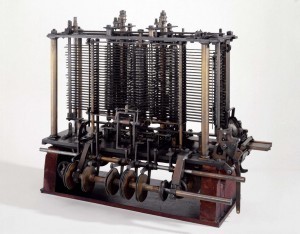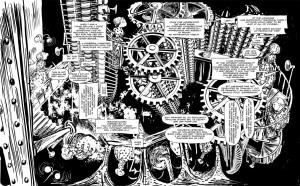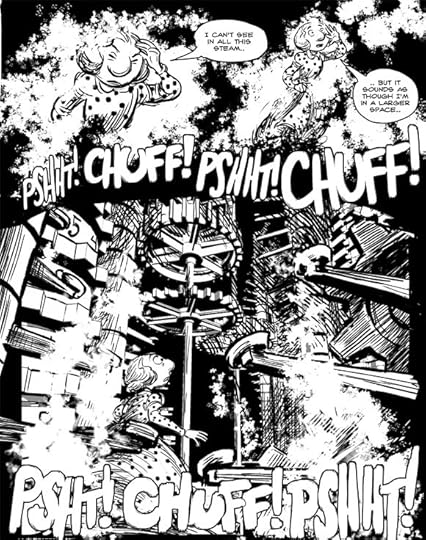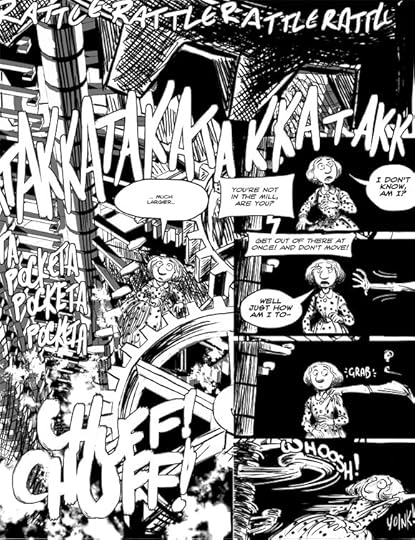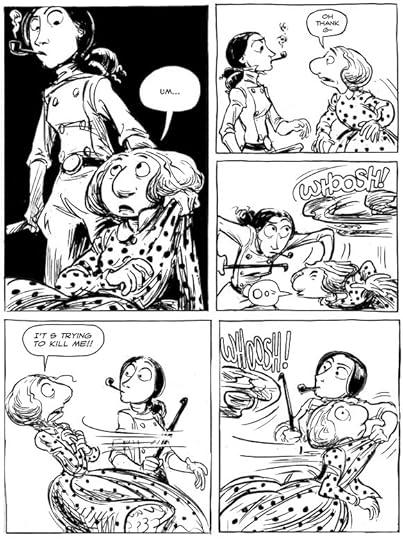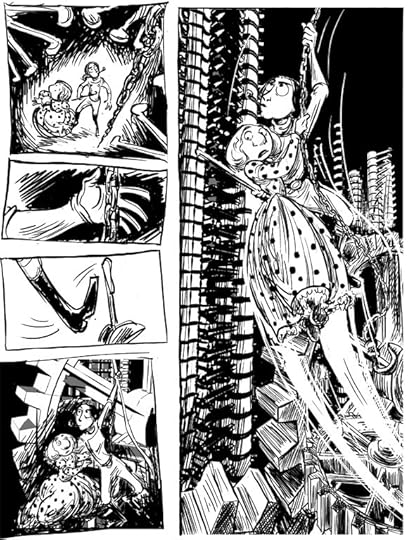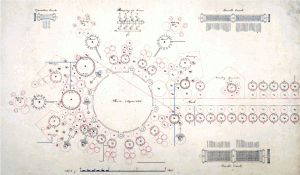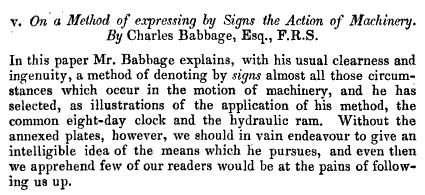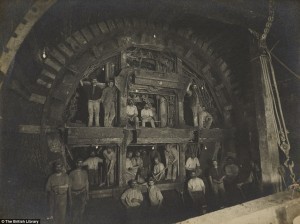Sydney Padua's Blog, page 4
March 26, 2013
Protected: User Experience The Final Chapter
This post is password protected. To view it please enter your password below:
Password:

User Experience The Final Chapter
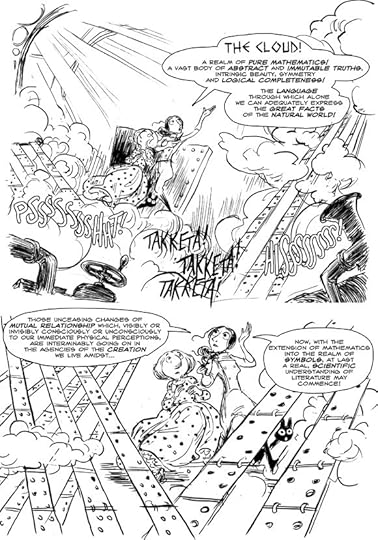
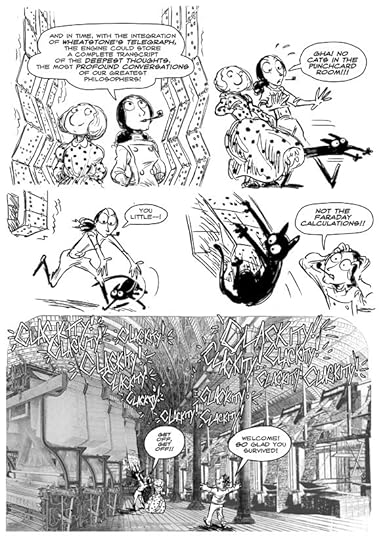
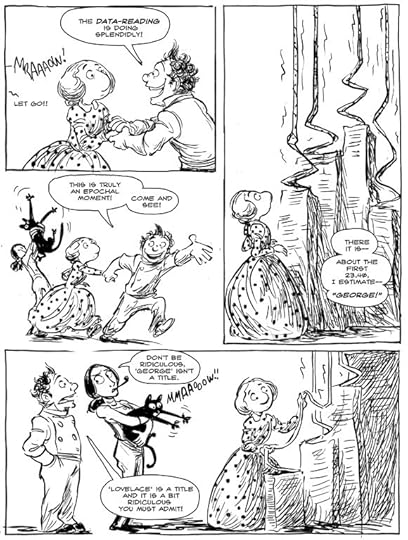
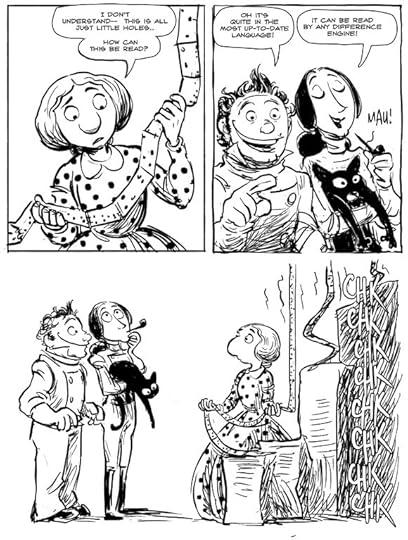
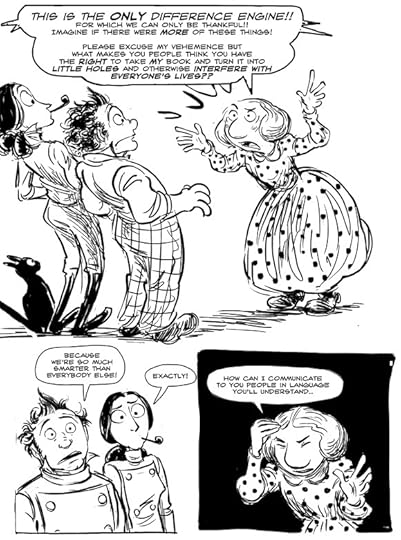
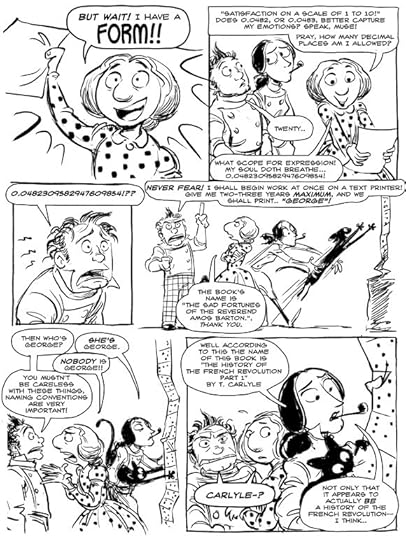

Whew! I don’t know about you but I’m off to bed with a snifter of Armagnac! But not before I gift you with the following NOTE:
The fate of Thomas Carlyle’s first draft of The History of the French Revolution, Part 1, is one of the most hilarious dreadful tragedies every to happen to somebody else. Neither Charles Dickens or Charles Babbage was responsible– it was that most moral of men, John Stuart Mill:
Well, one night about three weeks ago, we sat at tea, and Mill’s short rap was heard at the door. Jane rose to welcome him; but he stood there unresponsive, pale, the very picture of despair; said, half articulately gasping, that she must go down and speak to “Mrs Taylor” (his Platonic inamorata); with whom Jane fancied he must have at length run off, and so was come, before setting out for the Devil, to take solemn leave of us. Happily, no;—and yet unhappily! After some considerable additional gasping, I learned from Mill this fact: that my poor Manuscript, all except some four tattered leaves, was annihilated! He had left it out (too carelessly); it had been taken for wastepaper: and so five months of as tough labour as I could remember of, were as good as vanished, gone like a whiff of smoke.— There never in my life had come upon me any other accident of much moment; but this I could not but feel to be a sore one. The thing was lost, and perhaps worse; for I had not only forgotten all the structure of it, but the spirit it was written with was past; only the general impression seemed to remain, and the recollection that I was on the whole well satisfied with that, and could now hardly hope to equal it. Mill whom I had to comfort and speak peace to remained injudiciously enough till almost midnight.
I should ALSO add an interesting fact, which I shall certainly work into the next draft, that George may be a very silly title for a book but it’s a fine name for a planet– the (arguably unfortunately named) Uranus was named ‘George’ (after the King, to be sure) by Herschel (father of Babbage’s close friend by the by) on its discovery in 1781, and so it was called until 1850.
Goodnight!

February 16, 2013
User Experience 35-42
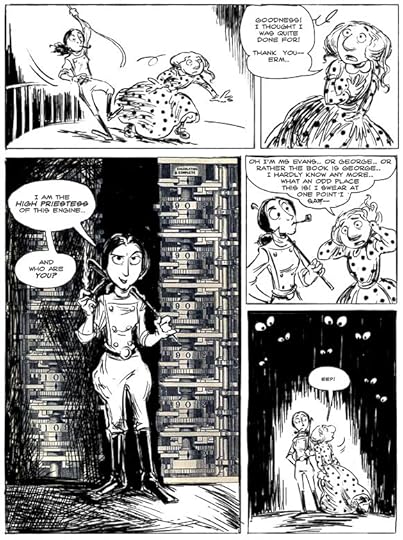
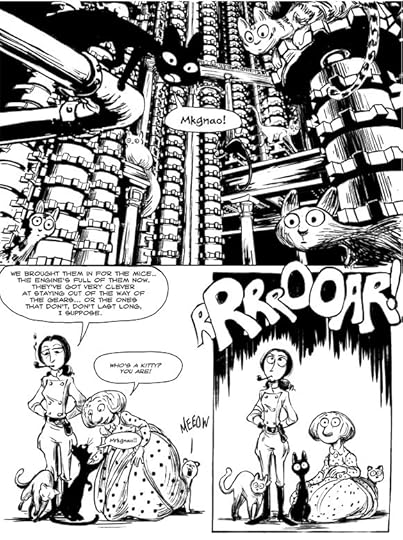
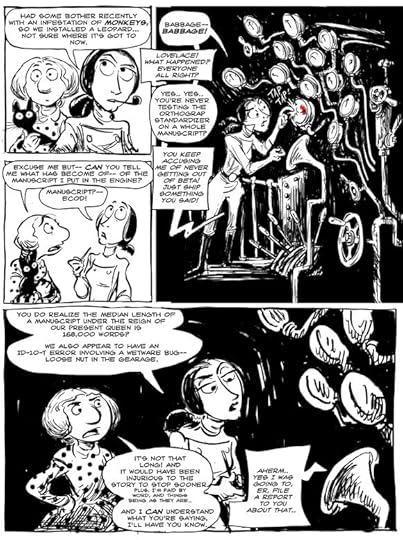
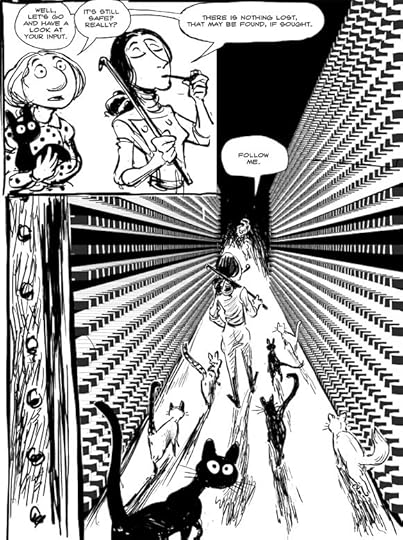
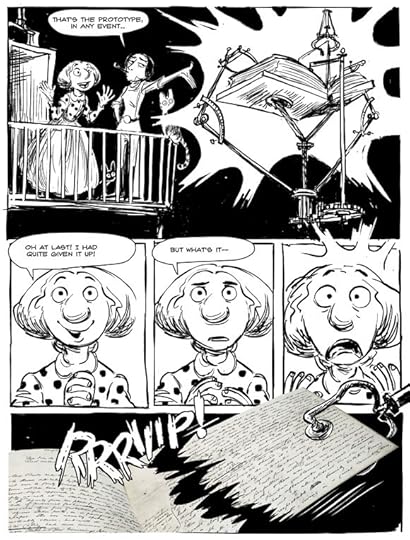
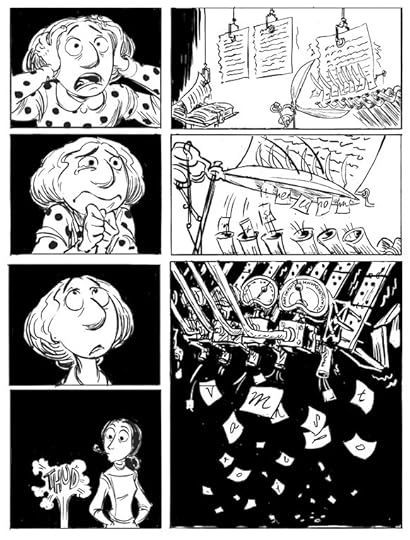
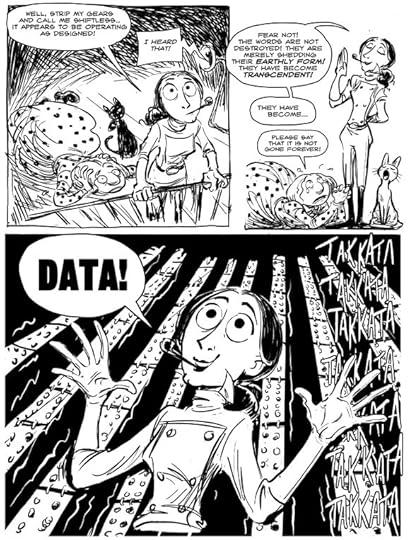
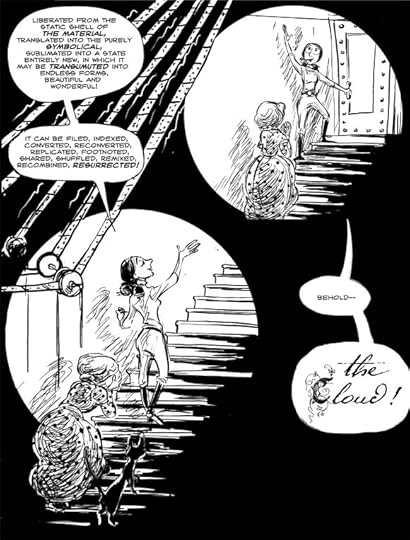
NOTES! WHICH YOU HAD BETTER READ ALL THE WAY TO THE END OR MISS AN EXCITING ANNOUNCEMENT!
- Lady Lovelace to her mother, 1843: “I had better continue to be simply the High-Priestess of Babbage’s Engine, & serve my apprenticeship faithfully therin”
- Lady Lovelace to Charles Babbage, 1848: “You say nothing of Tic-tac-toe– in yr last. I am alarmed lest it should never be accomplished. I want you to complete something.”
- Calumny! Victorian writers were not paid by the word, they were paid by the page. Though sometimes one wonders if they were paid by the syllable. And the median length is indeed 168000 words, thanks Wikipedia!
- the long corridor of teeth Lovelace walks down is the Rack, the part of the Analytical Engine designed to transfer the data from the Mill to the Store. Babbage’s son put together a model of it:
I have no real idea but I guess in principle it works like– the Engine engages the Rack, zeros out the wheel in the Mill, which moves the units to the Store? Or something. Apparently the punchcards control the engagement of the rack. Somehow. Jonesin’ for some diagrams, Analytical Engine people!
–Lovelace is quoting the Faery Queen there- poetry! She and Babbage called her ‘the Faery’ sometimes, I think they meant that kind not the Tinkerbell kind.
Sith thou misdeem’st so much of things in sight?
What though the sea with waues continuall
Doe eate the earth, it is no more at all:
Ne is the earth the lesse, or loseth ought,
For whatsoever from one place doth fall,
Is with the tide unto an other brought:
For there is nothing lost, that may be found, if sought.
Likewise the earth is not augmented more,
By all that dying into it doe fade.
For of the earth they formed were of yore;
How euer gay their blossome or their blade
Doe flourish now, they into dust shall fade.
What wrong then is it, if that when they die,
They turne to that, whereof they first were made?
–I am much indebted to Language Log for “Strip my gears and call me shiftless”– I knew I wanted one of what LL is pleased to call the ” and call me “ constructions, and that one shall we say meshed with my needs. My googling skills were not up to tracing how far back these go though, and it’s certainly an Americanism, but Lady Lovelace is Cosmopolitan.
AND FINALLY..
Lovelace and Babbage VS the Organist– coming to the Edinburgh Fringe Festival!
Keep an eye on intrepid sound-designer Fiona Keenan’s blog for the process!
Needless to say I am incredibly excited!
I’ll put up the dates when I have ‘em..
Oh oh one last thing.. you’ll never guess who dropped by with a comment on the page with the Zork gags.. I may indeed say with George, “Pleasant letters like yours are the best possible stimulus to an author’s powers.”

February 14, 2013
Happy Valentines Day!
Late but in earnest as always.. a Babbage Valentine to complete the set with Lovelace and Brunel from last year.
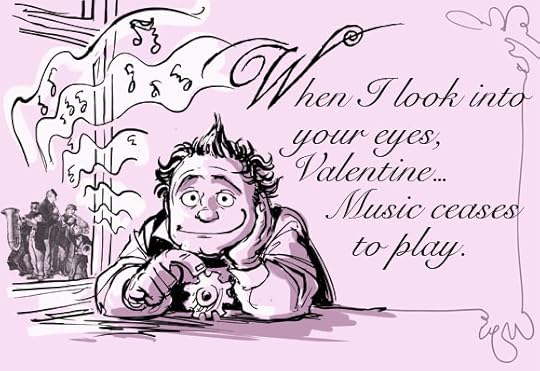
I can’t look into his eyes for too long, it gets unnerving..
Many thanks to @Suitov for the tagline, who won a short sharp twitter battle for comedy supremacy against many worthy opponents. Me I couldn’t get past the probably historically accurate but unromantic “Valentine, I love you more than I love my Difference Engine. HAHAHA of course not! But you are very nice.”
Lots more User Experience more shortly than you can possibly imagine..

February 12, 2013
User Experience 29-34
Six more pages, and apologies for another double-page spread- click for bigger. Further apologies for the format which will become obvious when you do so..
NOTES S??ON NOTES S??ON NOTES S??ON NOTES S??ON
The Loop page was originally designed for iPad, in which format I assure you it is EXTREMELY CLEVER, and I’ve been puzzled enough about how to adapt it for the printed page.. adapting it in a clever way for the web was one too many for me I’m afraid! Even its present form is a work in progress…
Babbage’s Analytical Engine allows for both branching conditionals– the if-this-then-thats (previously in User Experience) and loops, he described the initial glimmerings for its development from the idea of the Difference Engine ‘eating it’s own tail’.
The dialogue between George and Babbage is a pastiche of some of their writings– Babbage describes his Universal Language in his autobiography; George was talking about forms of language and poetry in an unpublished essay (you can find it in the collection edited by A.S. Byatt, if you’re so inclined). Babbage declared his annoyance with the existence of different languages and the subsequent loss of efficiency to friction at the Proceedings of the International Statistical Congress. If you’re interested in Universal Languages I much enjoyed In the Land of Invented Languages, which has a large section on Wilkins, mentioned by Babbage in the autobiographical except above. His spatial, modular, symbol language reminded me of Babbage’s mechanical notation.
The Mill is what Babbage called the CPU of his engine. It’s depiction here is quite incorrect, to judge from his diagrams the middle of the Mill would be one of the safest places to stand in the whole engine. Just another example of the misinformation shamefully promulgated by this comic.
Speaking of misinformation, I am given to understand (though I’m a bit fuzzy on it to be honest) that the beautiful yet deadly carry arms than almost decapitate George were not used in the Analytical Engine, having been superseded by a more efficient design. Which is a shame as while they might cost some fractions of a second in calculation, surely the contribute enough sheer joy to offset the expense? You can see them in operation in the model of the adding mechanism here– you can see how the flange nudges the little widget when it goes past 9, putting it in ‘ready’ position to be kocked over one more unit by the carry arm- erm writing that out has given me some sympathy with the inadequacies of language to convey complex mechanical movements..
Difference Engine Adder, test 1, Back View from Sydney Padua on Vimeo.
Oh quick addendum! There is a Ada Lovelace Conference coming up! Conveying the call for papers:

February 4, 2013
User Experience 24-28
Here you go! There’s a 2 page spread in there you’ll have to click to enlarge..
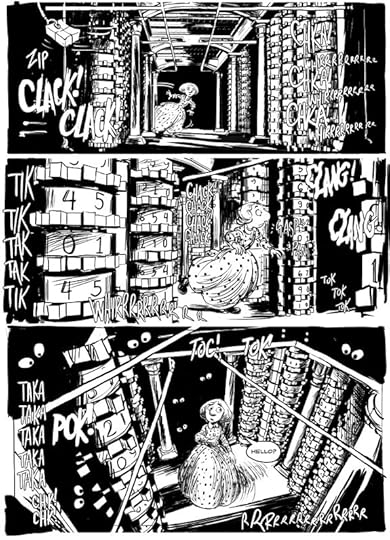
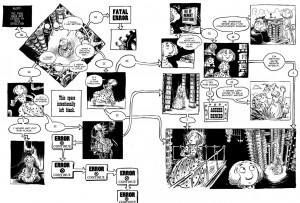
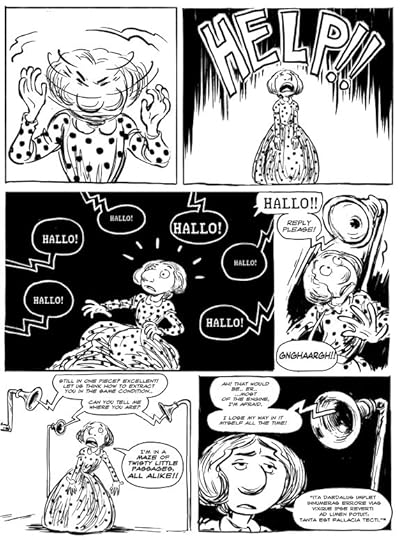
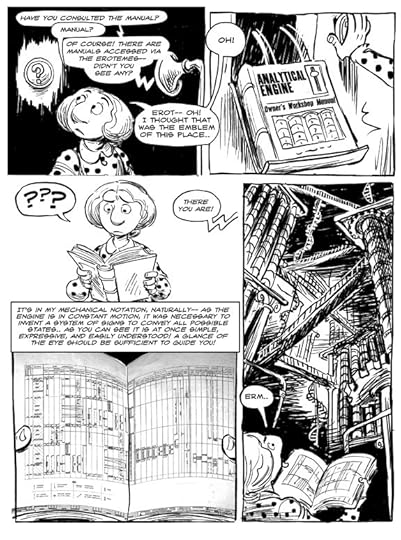
Notes, read them or be eaten by a Grue!
No doubt Babbage is kicking himself for not having invented the flowchart, a notation which would have been much after his way of thinking.
Readers of this comic will know how old they are by their recognition of Zork jokes. I myself am old enough to have spent a summer at a university youth program playing Zork on a TELETYPE (warning, LOUD youtube link!), I kid you not (I believe I was meant to be learning elementary statistics, which is surely what all 13 year old girls REALLY want to be doing all summer..). To all saying “Surely you can’t be that old!” oh bless you hearts.
The latin (YES THIS TIME IT’S REALLY LATIN!) from Ovid’s Metamorphosis:
Great Daedalus of Athens was the man
That made the draught, and form’d the wondrous plan;
Where rooms within themselves encircled lye,
With various windings, to deceive the eye.
As soft Maeander’s wanton current plays,
When thro’ the Phrygian fields it loosely strays;
Backward and forward rouls the dimpl’d tide,
Seeming, at once, two different ways to glide:
While circling streams their former banks survey,
And waters past succeeding waters see:
Now floating to the sea with downward course,
Now pointing upward to its ancient source,
Such was the work, so intricate the place,
That scarce the workman all its turns cou’d trace;
And Daedalus was puzzled how to find
The secret ways of what himself design’d.
I’m going to spend all day rooting around for a thing I’m sure I have stashed somewhere of Babbage describing his difficulties in understanding his own engine! The intricacies of his device led him to several goes at creating what a ‘mechanical notation’– some of which bear a pleasing resemblance to circuit diagrams. It’s hard to think of a mechanism of the period that would have needed such a detailed system, but Babbage himself considered it one of his greatest inventions and was painfully sore at not having this opinion universally shared.. or as shared at all, as far as I can tell!
Mechanical Notation in his autobiography (with bonus THOSE FOOLS AT THE ROYAL SOCIETY rant)
His first paper on his notation, 1826
Covered along with other attempts at kinematic notation, in the fascinating Kinematics of Machinery, translated from the French (always bigger Babbage supporters than the English) in 1876. Quotage:
No notice was taken of it by those practically interested in machinery, and by this want of attention they added unconsciously to the great irritation which displayed itself in the work which Babbage published shortly before his death [editor pauses to hug Babbage]. In this he struck about him most vehemently, like Timon of Athens with his spade, accusing his contemporaries of their want of comprehension and appreciation of his work. Without in the least depreciating, however his most important labours in other directions, it must be said that the cause of the non-acceptance of his system of notation was due to its own defects, and not to those of the public [editor pauses to hug F. Reuleaux, author of 'Kinematics of Machinery']
An interesting attempt to extend on Babbage’s system, 1870 (with *ahem!* extensive quotations from Babbage’s writings not clearly indicated..)
And finally, a dismaying lack of faith in their readership from the Quarterly Journal of Science, Literature, and the Arts
I assure you I automatically assume every single one of MY readers will devote the next weeks of their lives to a careful study of all these documents!

January 28, 2013
User Experience Pgs 18-23
Bunch o pages!

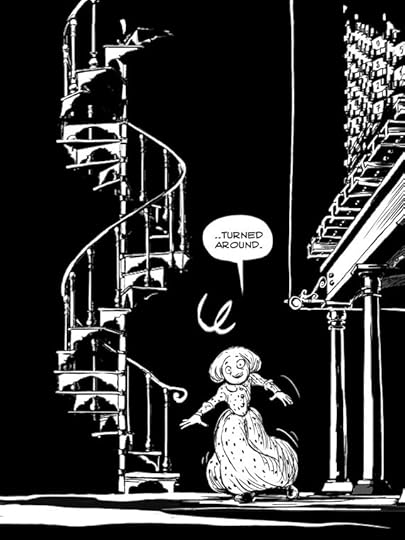
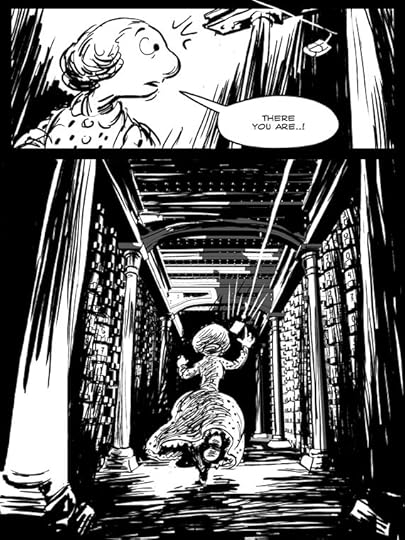
Couple of notses.. sorry these are so short, there’s a heap of notes I’m working on but they’re a little complicated!
It is still possible to believe that the attorney was not more guilty toward him than an ingenious machine, which performs its work with much regularity, is guilty toward the rash man who, venturing too near it, is caught up by some fly-wheel or other, and suddenly converted into unexpected mince-meat.
I should note that George Eliot does not approve of the way I draw her hair..
“She has abolished all my curls, and made two things stand out on each side of head like those on the head of the Sphinx. All the world says I look infinitely better; so I comply, though to myself I seem uglier than ever– if possible.”
Hmmm..
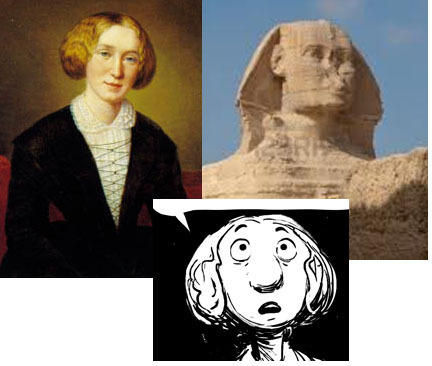
Guilty as charged!
Oh– ‘lasciate ogni speranza voi c’entrate’- abandon all hope ye who enter– is written above the door to hell in Dantes Inferno.. I shall have to go back and put in a LOT more latin quotes for George’s dialogue. * Multitudinous genti point out that The Inferno is in Italian not Latin.. just seeing if you’re paying attention ey ey ey!!

January 20, 2013
User Experience Pgs 13-19
Here you go! Late but in earnest! A slew of pages..
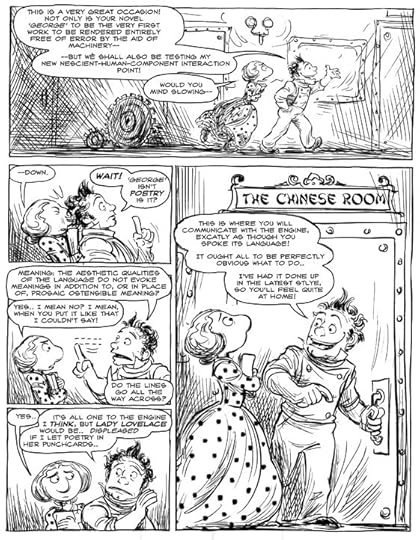
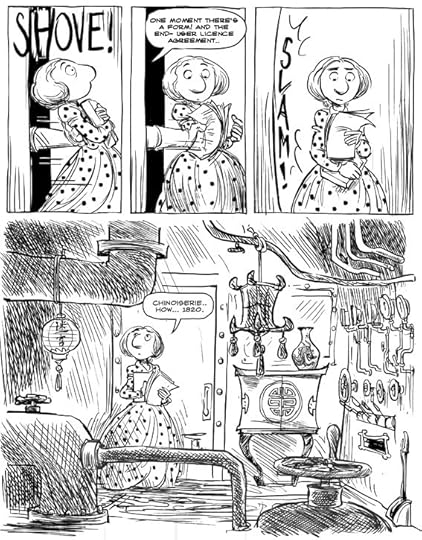
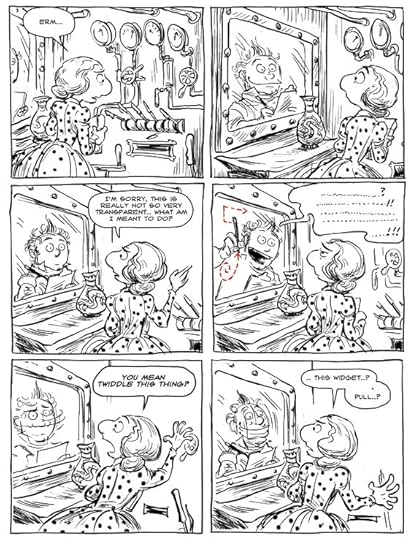
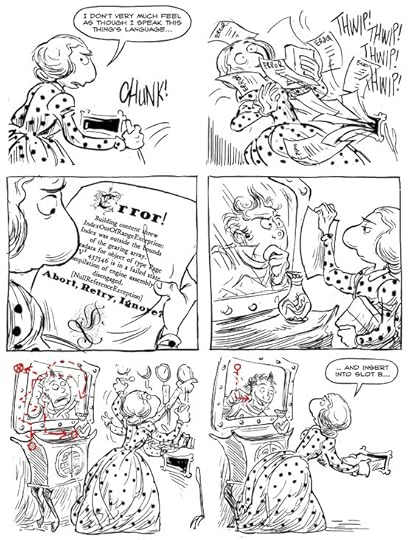
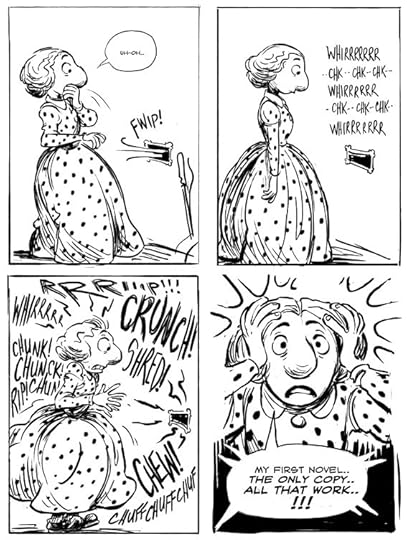
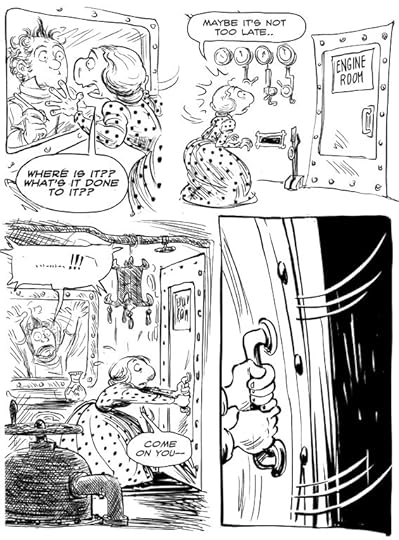
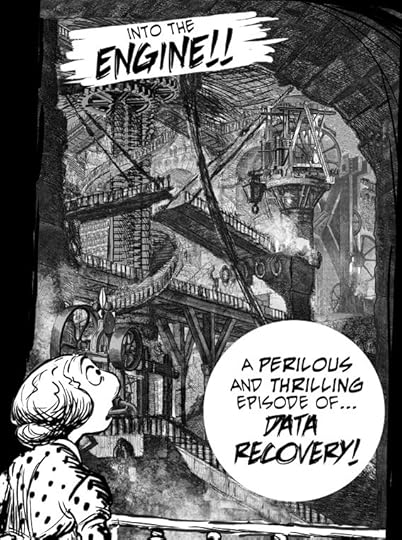
SNOOOOTES!
The Chinese Room is a famous thought experiment which is a kind of a challenge to the Turing Test for successful Artificial Intelligence. I don’t know much about it (there’s tons of reading here and here) except that it’s pretty funny.
A couple of other little things-
I have a short interview about the book here, including when it’s coming out, maybe (spoiler: don’t hold your collective breath *sigh*)
But when it DOES come out, I’ll be one of the millionaires you hear about who cashed in on the upcoming Steampunk Boom! Soon to be followed by the moral lessons of the calamitous Steampunk Bust, with its sad piles of discarded goggles and overdrawn top-hatted bankrupts leaping from their airships.
Short notes because I’m going out to play in the snow! More comics before you know it!

January 15, 2013
150 Years of the Underground vs the Mole Folk
Happy 150th Birthday London Underground! You great heaving wonderful signal-failuring engineering-worksing glorious mess you!
For the occasion they ran a steam engine along part of the Hammersmith and City line and I got to go! Not, as you might think, in deference to my Victorian engineering comics fame, but on account of I won the lottery draw for a chance to pay a ton of money.
View from inside the carriage!
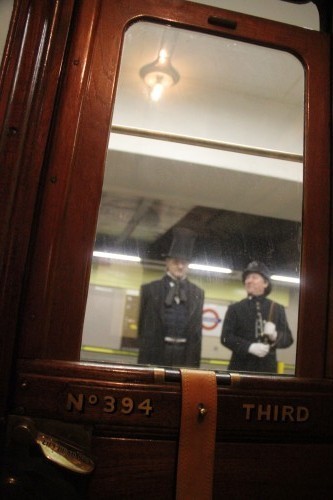
Should you happen to be in the teeming metropolis of London this coming Sunday- the 20th of January– you can watch the final journey along the Hammersmith and City line. It’s pretty magical! Some great tips on the timetables and best views at the indispensable IanVisits. (from my perspective in the train, Barbican and even Kings Cross were pretty empty on the flyby just after 10pm).
-
-
-
-
-
-
-
-
-
-
-
-
-
Naturally I did some sketches FROM LIFE (sketches not from life)
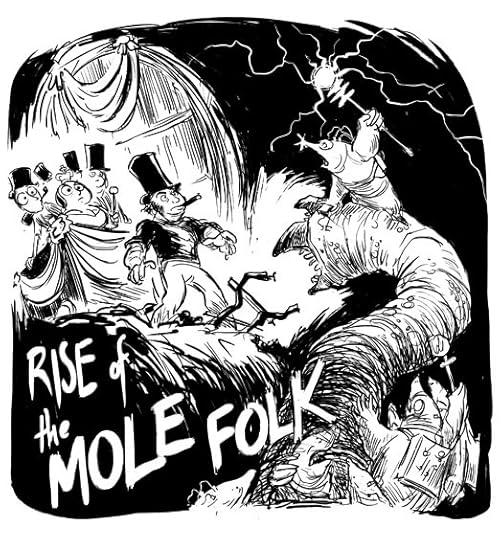
Isambard Kingdom Brunel, Under-London-tunnel-and-railway expert, died too young to have a hand in the Underground in our universe, which just goes too show you what a sad, mole-folk-less desolate place universe our is. Sigh. However, it did make much use of his father Marc Brunel’s innovative tunnelling shield. The design of the shield, by the way, was inspired by the tunnelling shell-mouths of the mole-folk’s electrified-battle-worms shipworm (warning: links to picture of a shipworm), which I see from that article is inspiring further bio-imitative technology. But I digress.
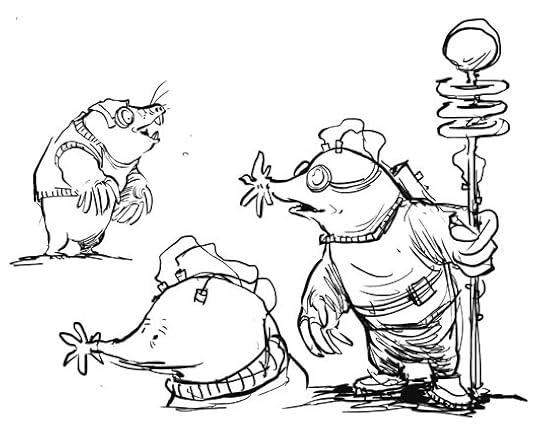
Unlike the simple Salamander People, the sophisticated Mole Folk have mastered electricity and telepathy (gained from ingesting the mysterious products of their Marmite mines); they’re such formidable opponents that it’s a good thing the conflict seems to have been resolved peaceably, as I surmise from this Historical Document:
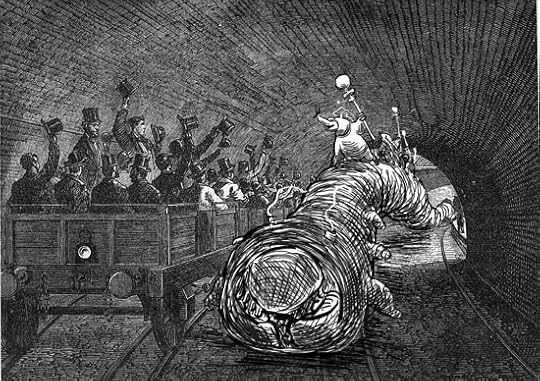
A miscellany of links for the occasion:
Lots of great shots at the London Transport Museum’s Flickr
A Very Very Verbose Visit to the Underground, courtesy of the always excellent Cat’s Meat Shop.
Here’s a great piece of history all dressed up in the finest polysyllabic prose– A Twenty Minute’s Letter To The Citizens of London, In Favour of the Metropolitan Railway and City Station. By your faithful correspondent the worthy Charles Pearson, a pitch for selling shares for this crazy idea of an underground railway, not an easy thing to do after the dot-com style railway bubble of the 1840s- “that maniacal period of speculation”, as he terms it. What could possibly be more Victorian than this passage-
The City of London is inhabited by a more crowded and active population, better able and more willing to pay for Railroad accommodation, than any other locality in the world. The organs of public opinion– the columns of the daily press– record, what our own personal observation proves, that the moving masses in our public thoroughfares are most seriously obstructed by the carriages and carts which throng our streets, and are daily increasing with the daily increasing population, commerce, and wealth of the City and the surrounding districts. The decennial census, and the reports of the officers of health and of the visting clergy in the City, record the fact that our courts and alleys are crowded with a stagnant mass of human beings of the lowest class, intermingled with the families of respectable working men, who have the mans and disposition to migrate, like their masters, if they had facilities wich a Railroad would afford them, and to live with their families in the country, a few miles from the locality of their occupation.
Anyways, we return triumphant to User Experience shortly, with a whole heap of pages for you.. I couldn’t get used to the rhythm of doing one page at a time, the comic seems to want to erupt all at once in ill-regulated explosive intervals, like the capricious volcano-god of the Salamander People. What can I do!

January 4, 2013
User Experience Page the Twelfth!
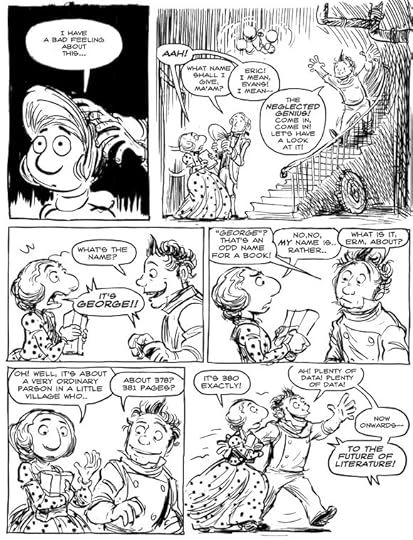
This comic is about … heaven knows!
No notes that I can think of! The first edition of Scenes of Clerical Life is exactly 380 pages though.


